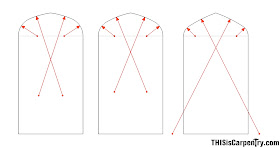The focus of my work as a masonry designer has been
manufactured concrete block. I have
chosen to focus on this specific field of masonry because it presents a way to
have a large impact on how we build things.
The concrete block industry is ubiquitous, with block manufacturers
found throughout the US and around the globe.
The science and engineering used to manufacture concrete block have been
developed to a high art; the methods and materials used by this industry have
evolved over the past hundred years or so to an incredibly high state of
efficiency and economy: very high
strength concrete masonry units are produced and sold at a very low cost. The consumer reaps the benefits of over a century
of science and engineering development and is able to purchase this superior masonry
product at a very low price.
Manufactured concrete block represents incredible value to the consumer.
Introduction of a new masonry unit which employs the
machinery, manufacturing equipment, materials, and distribution processes
developed by industry stands on the shoulders of over a century of genius and
ingenuity of skilled engineers and the hard work of block makers and working
masons. Thoughtful design allows a
maximum benefit of the existing infrastructure of the concrete block industry. A new design should work well with the
existing materials, equipment and processes already in place.
The challenge of introducing a new masonry design to the
manufactured concrete block industry is creating a business model which creates
greater profits for the block maker and a better product at a low cost for the
consumer while still providing some profit for the masonry innovators who bring
new designs to market. How is this done?
The key to achieving these goals is high volume of
production. Since the product (concrete
block) must be sold at a relatively low cost to stay competitive with other
forms of construction, a large volume of this product must be sold. This has long been realized by industry, and
is the driving principle behind the development of concrete block manufacturing
equipment. This principle has brought
block manufacturing to the highly efficient state of development in which it
exists today.
The block designer has to provide a value proposition to the
block maker. In my case, the value
proposition is that the block maker will sell more product at a higher price
and make greater profits. We can do this
by providing use of our molds to the block maker at no cost. The very high efficiency of block making
equipment means that a block maker can produce substantial inventory of product
in a relatively short time. This means
that the block maker does not require a set of molds to be in constant use:
inventory for a year’s worth of sales can be produced in a relatively short
time. This means that molds can be rotated
among different manufacturers, and a given set of molds is shared among a
number of block manufacturers.
The masonry system I have developed creates a better
building system at a lower cost for the consumer. This is the value proposition for the
customer: a better building at a lower cost.
Since the entire building is made from manufactured block, the consumer
purchases a higher volume of block. This
meets the needs of both the consumer (a better building at lower cost) and the
block maker (higher volume of sales and greater profits).
Finally, there must be profit for the developer who brings
an improved masonry product to market.
We must recoup the substantial investment in molds, the costs of product
development, and the costs of sales; while finally still providing profit. This is achieved through royalties. The masonry designer does not pay the block
maker to produce block beforehand, and the block maker does not pay the
designer until block are sold. The block
designer gets a percentage or a royalty on block sold by the manufacturer. Again, the key to this is a high volume of
sales. The masonry system I have
developed requires a large number of block because the entire building is made
of block: this is how high volume of sales is achieved. To make this feasible it is necessary for the
number of block made and sold by the manufacturer to be measurable and
verifiable. This is typically achieved by gauging the
rate of mold wear on a set of molds. A
typical set of molds is usually good for around 100,000 production cycles
before wear parts on the mold need to be replaced (e.g., if a mold produces 2
block per cycle, then production is 200,000 masonry units before wear parts are
replaced). It is also possible to simply
sell the mold to a block maker; however the production capacity of a set of
molds will usually exceed the total sales of a specialty block. It makes more economic sense to rotate the
mold among various block manufacturers.
This also saves the block maker the expense of having to purchase molds.
Using this business model, we can meet the needs of the
block maker and the customer while still creating substantial profit. Our current model is able to produce a very high
strength, fireproof, very low maintenance, attractive building envelope for a cost
of around $10 per square foot; average costs of building envelopes are
typically around $200-350 per square foot (we create an incredible value for
consumers). This model avails itself of
the high efficiency of the concrete block manufacturing industry and creates a
superior construction system at a lower cost.
The customer gets a better
building at a great value, and the block maker and masonry designer realize
more profits.


































